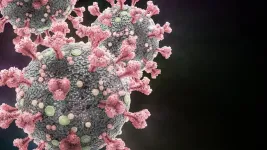The Trojan-Horse mechanism: How networks reduce gender segregation
2021-04-16
(Press-News.org) The social science literature has long viewed homophily and network-based job recruitment as crucial drivers of segregation. Researchers at Linköping University and ESADE, Ramon Llull University now show that this view must be revised. In their Science Advances article, they call attention to a previously unidentified factor, the Trojan-horse mechanism, which shows that network-based recruitment can reduce rather than increase segregation levels.
The segregation of labor markets along ethnic and gender lines is an important source of socio-economic inequalities. Therefore, the understanding the mechanisms that drive segregation processes is of utmost importance.
Individuals often find their jobs through friends, colleagues, and acquaintances. Analyses of the role of labor-market networks in segregation processes has usually centered on homophily - the tendency to like and to befriend others who are similar to oneself. If individuals recruit friends or acquaintances, the homophily argument suggests that labor markets are likely to become more segregated, because individuals with similar characteristics then tend to agglomerate at certain workplaces.
What previous research has overlooked is the importance of restricted opportunities. Both females and males prefer to form ties with individuals of the same gender, but if an individual works in a workplace where most employees are of the opposite gender, the individual is likely to form ties to those of the opposite gender.
"The Trojan-horse mechanism shows how constraints on the formation of same-gender ties within workplaces affect mobility patterns between workplaces and thereby the gender segregation of the labor market. When an individual changes job and moves from one workplace to another, colleagues are likely to subsequently follow the same path", says Professor Peter Hedstrom at the Institute for Analytical Sociology, Linkoping University.
The Trojan-horse mechanism predicts that when an individual leaves a workplace in which he/she is in a minority, he/she is likely to be followed by majority-group individuals. This implies, in turn, that an initially segregating move can set in motion a chain of desegregating moves. In other words, the mechanism shows how networks can counteract the segregating impact of a mobility event.
To test this prediction, a large-scale longitudinal register dataset is used with rich demographic and socioeconomic information, as well as detailed mobility records, for every individual and every workplace that ever resided in the Stockholm metropolitan area during the years 2000-2017. The number of workplaces included in the analyses ranges from 20,000 to 30,000 each year, and the number of individuals is about 700,000 at every given point in time. The analyses offer strong empirical support for the Trojan-horse prediction.
The results presented provide important pieces of the larger causal puzzle that, once solved, will allow of us to steer segregation processes in more desirable directions. In and of itself, the Trojan-horse mechanism is also of importance for everyday organizational practices.
"For efficiency as well as affirmative-action reasons, workplaces often want to hire individuals of the underrepresented gender. What these results suggest is that recruiters who want to increase diversity or change the gender balance of the workforce should pay attention not only to the gender of the recruited individual but also to the gender composition of the workplace from which the individual is recruited", says Professor Peter Hedstrom at The Institute for Analytical Sociology, Linkoping University.
INFORMATION:
[Attachments] See images for this press release:

ELSE PRESS RELEASES FROM THIS DATE:
2021-04-16
Science Advances publishes proteomics technology from Oblique Therapeutics AB with a potential to bring several novel antibody medicines to large patient populations in multiple disease areas
Gothenburg, Sweden, April 16th, 2021 - Oblique Therapeutics AB, a Sweden-based biotech company, in collaboration with Karolinska Institutet (Stockholm, Sweden), Gothenburg University (Sweden) and several local biotechs published promising research results in the highly-acclaimed scientific journal Science Advances (AAAS) entitled: Rational Antibody design for Undruggable Targets using Kinetically Controlled Biomolecular ...
2021-04-16
New Haven, Conn. -- It is well established that autism occurs much more frequently in boys than in girls, and that girls seem to have a greater resilience to developing the condition. It has been unclear, however, why that is.
In a new Yale-led study, researchers find that autism may develop in different regions of the brain in girls than boys and that girls with autism have a larger number of genetic mutations than boys, suggesting that they require a larger "genetic hit" to develop the disorder.
The findings appear in the April 16 edition of the journal ...
2021-04-16
Aging entails a loss of muscle mass and strength, which in some cases impairs mobility, hinders walking or performance of day-to-day tasks, and exposes the elderly to the risk of falls and hospitalizations.
In clinical practice, handgrip measurement is the most widely used method to identify loss of overall muscular strength in older people. Values below 26 kg for men and 16 kg for women have for some time been considered an indication of risk-associated weakness, but these parameters are being revised.
Researchers at the Federal University of São Carlos (UFSCar) in the state of São Paulo, Brazil, collaborating with colleagues at other institutions in the same state such as the University of São Paulo's Ribeirão Preto Medical School (FMRP-USP), Nursing School ...
2021-04-16
Although antibodies induced by SARS-CoV-2 infection are largely protective, they do not completely protect against reinfection in young people, as evidenced through a longitudinal, prospective study of more than 3,000 young, healthy members of the US Marines Corps conducted by researchers at the Icahn School of Medicine at Mount Sinai and the Naval Medical Research Center, published April 15 in The Lancet Respiratory Medicine.
"Our findings indicate that reinfection by SARS-CoV-2 in health young adults is common" says Stuart Sealfon, MD, the Sara B. and Seth M. Glickenhaus Professor of Neurology at the Icahn School of Medicine at Mount Sinai and senior author of the paper. "Despite a prior COVID-19 infection, young people can catch the virus ...
2021-04-16
In recent years there has been an exhaustive study of red dwarf stars to find exoplanets in orbit around them. These stars have effective surface temperatures between 2400 and 3700 K (over 2000 degrees cooler than the Sun), and masses between 0.08 and 0.45 solar masses. In this context, a team of researchers led by Borja Toledo Padrón, a Severo Ochoa-La Caixa doctoral student at the Instituto de Astrofísica de Canarias (IAC), specializing in the search for planets around this type of stars, has discovered a super-Earth orbiting the star GJ 740, a red dwarf star situated some 36 light years from the Earth.
The planet orbits its star with a period of 2.4 days and its mass is around 3 ...
2021-04-16
One of the most comprehensive statistical analyses of drivers of food insecurity across 65 countries has concluded that household income consistently explains more discrepancy in food security than any other factor, including agricultural land resources and production. The Thayer School of Engineering at Dartmouth study, "Cross-national analysis of food security drivers: comparing results based on the Food Insecurity Experience Scale and Global Food Security Index," was recently published by the peer-reviewed journal Food Security.
Given the persistent issue of food insecurity--one of the United Nation's sustainable development goals is to achieve zero hunger--the study's results are vital in determining how best to tackle the complex problem.
"We're ...
2021-04-16
Boulder, Colo., USA: Volcanologists' ability to estimate eruption risks is largely reliant on knowing where pools of magma are stored, deep in the Earth's crust. But what happens if the magma can't be spotted?
Shane Rooyakkers, a postdoctoral scholar at GNS Science in New Zealand, grew up in the shadow of Mount Taranaki on the country's North Island, hiking on the island's many volcanoes. Today, his research is revealing hidden dangers that may have been beneath his feet all along.
A new study, published yesterday in Geology, explores a threat volcanologists discovered only recently: surprisingly shallow magma pools that are too small to be detected with common volcano monitoring equipment. Such a magma body was ...
2021-04-16
LA JOLLA, CALIF. - April 16, 2021 - Scientists at Sanford Burnham Prebys have identified a set of human genes that fight SARS-CoV-2 infection, the virus that causes COVID-19. Knowing which genes help control viral infection can greatly assist researchers' understanding of factors that affect disease severity and also suggest possible therapeutic options. The genes in question are related to interferons, the body's frontline virus fighters.
The study was published in the journal Molecular Cell.
"We wanted to gain a better understanding of the cellular response to SARS-CoV-2, including what drives a strong or weak response to infection," says Sumit K. Chanda, Ph.D., professor and director of the Immunity and Pathogenesis Program at Sanford Burnham Prebys and lead ...
2021-04-16
Scientists have figured out how to modify CRISPR's basic architecture to extend its reach beyond the genome and into what's known as the epigenome -- proteins and small molecules that latch onto DNA and control when and where genes are switched on or off.
In a paper published April 9, 2021, in the journal Cell, researchers at UC San Francisco and the Whitehead Institute describe a novel CRISPR-based tool called "CRISPRoff," which allows scientists to switch off almost any gene in human cells without making a single edit to the genetic code. The researchers also show that once a gene is switched off, it remains inert in the cell's descendants for hundreds of generations, unless ...
2021-04-16
Look deep inside the brain of someone with Alzheimer's disease, most forms of dementia or the concussion-related syndrome known as chronic traumatic encephalopathy (CTE) and you'll find a common suspected culprit: stringy, hairball-like tangles of a protein called tau.
Such conditions, collectively known as "tauopathies" strike scores of people across the globe, with Alzheimer's alone affecting six million people in the United States.
But more than a century after German psychiatrist Alois Alzheimer discovered tau tangles, scientists still have much to ...
LAST 30 PRESS RELEASES:
[Press-News.org] The Trojan-Horse mechanism: How networks reduce gender segregation




